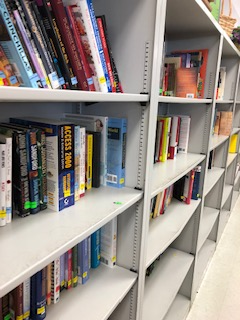10/10 Book-Lovers and Creative Folks Agree...
Books and prompts make the BEST holiday presents.
Get a jump-start on your shopping with one of my three AWESOME books and some prompt cards to boot. Hey, stockings also have to be filled, right? ;) I’ll be happy to sign the books with any inscription you’d like. :)
Peruse these classics, make your list, and no need to stand in line or check twice! :) Just break out your gift wrap and surprise them with these inspiring treats:
For the writer of fiction or nonfiction in your life: In a Flash: Writing & Publishing Dynamic Flash Prose. (New to my shop this season!)
For the poet in your life or your favorite poetry workshop or classroom (sponsor a classroom with this lovely book— guaranteed to make students from middle school through grad-school smile and make a teacher’s day): Poetry Power: An Interactive Guide for Writing, Editing, Teaching, and Reflecting on the Life Poetic. (New to my shop this season!)
For the history-buff, teacher, poet, deep-thinker, and/or librarian in your life, there’s this wonderful historical poetry collection: This Passing Fever: 1918 Influenza Poems. (New to my shop this season!)
For the journalers and writers in your life. Makes a perfect gift for Secret Santas or to tuck into a care package for your favorite college student. Renewed: 30 Affirmation Cards.
Does your friend, love, or family member prefer the ever-so-thoughtful and personalized? I’ve got you covered. Commission your own poem. Le voila! Meaningful Poem Art—Typed.
My Prompt Cards make the perfect addition for inspiration for any traveler, writer, teacher, student, or creative in your life. Also, a great stocking stuffer.
Image courtesy of freestocks.org at unsplash.com
Catching the Send-Off Train
Looking up a link to my themed chapbook, Catching the Send-Off Train, that was published in 2013 to share with my poetry class this afternoon, I stumbled across a beautiful review on Goodreads by a reader I don't even know. [Open hanky, commence weeping.]
"Wow! This powerful chapbook of poems, following a woman whose husband is called to duty in World War II and her son dealing with his absence, speaks of and for those left behind. Pathos without maudlin sentimentality is present in every line, making this little collection speak as if set in any war, for any family."
What a moving, unexpected experience for an author on a paperwork-clogged, rainy Monday. Our writing makes a difference in this world; never forget it! :)
By the way, this collection, called Catching the Send-off Train, is still available for free for anyone interested in reading the poems and/or using them in your classroom(s) or workshops. Kindle editions also available. With Veterans Day around the corner, this book might be just the thing. #authormoment #pinchme #writerdreammoment #thiswritinglife #writeon
Another, earlier review of the poems in this collection : “Terrific book…. Firm language, and tremendous suggestive facility with visuals. This book often tells more by what it is not directly said.”
Photo by Alfred Eisenstadt, April 1943
(first printed in LIFE, February 14, 1944)
November News: Poetry and Photos Published :)
New month, new publication news! As the leaves do their twirl-dance from treetops, I have some new work dropping as well.
The Australian journal, Meniscus, is featuring a poem in their current (volume 6.2) issue.
Also, six of my photos were published in the current issue (issue 5) of And So Yeah literary magazine.
"Idling," Short Story Published :)
Happy Halloween, Ya’ll! :)
Check out my romantic-suspense themed short story, “Idling,” out today at SunLit Story Time.
Photo Courtesy of Hugh McCann, unsplash.com
It's Publication Day! :)
It's my book birthday! Welcome to the world, Poetry Power!
Photo courtesy of Kyle Head at unsplash.com
My subtitle says it all: “An Interactive Guide for Writing, Editing, Teaching, and Reflecting on the Life Poetic.”
Write poetry? You know you need some new prompts. Teach? Your students will thank you for this advice and for the publishing tips. Have some poet friends in your workshop or writing group? I hear that their birthdays and the holidays are just around the bend.
Signed copies available (pm me).
Ebook and tactile copies available at Amazon and Vine Leaves Press.
Exciting Spring Class! Register Now-- Photography for Writers :)
I’m happy to announce that I’ll be teaching my four-week Photography for Writers class again this spring.
Beginning on April 5, 2019, this class is tremendously fun and a great way for writers to sharpen their photography muscles and vice versa. No photography experience necessary, and you can use whichever kind of camera (including camera phone) you’d like.
For more details and to sign up to reserve your spot in this cool online workshop now, please visit: Imagery Power: Photography for Writers. Feel free to message me with any questions.
Photo courtesy of Alfonso Reyes, https://unsplash.com
Featured Artist Today :)
Guess who’s the featured photographer today over at Fourth & Sycamore. Check out this still-life photo from my “In the Green” series.
Remembrancer2
Nikon camera shot, courtesy of Joseph Chan at unsplash.com
"How Sweet it is: Writing Resonant Flash Prose"
My craft article was published as a spotlight today at Women on Writing. If you’re interested in writing more flash, check out my online class that starts on November 2nd. :) In a Flash
“How Sweet it Is: Writing Resonant Flash Prose”
By: Melanie Faith
When I was a kid, my dad used to stop on the way home from work each night to get the newspaper for my mom and a candy treat for me and my sister. One of our favorite treats was wrapped in a long, thin piece of see-through cellophane. Inside, was a string of thick white floss that had elasticity, and strung along this floss were shiny, bright candies. These circular gems, in popping pastel shades of yellow, pink, orange, and blue, were vaguely-sweetened like fruit and floral flavors (the yellow was slightly tart yet banana-ish and the blue, I recall, tasted like a cross between raspberry and the way a rose smelled).
Each candy bead had the kind of brittle crunch that a child relishes—chomp-chomp!—but which would make my adult teeth weep. The hues of the candies melted with each chomp until the string was bare and vaguely pinkish-whitish-yellowish-blue-orange by the time the last candy was presto-change-oed. After just a few moments, the candy dye bled onto fingertips, tongue, and face, revealing opaque-white candies’ underbellies.
A vivid sense memory I repeat is the internal debate—holding the cellophane-wrapped treat, after a hug from my dad: should I rip into the cellophane immediately and wear the candy-pretty necklace (sometimes I doubled it around my wrist like a fancy lady’s bracelet)? Yet, there was the candy, so tantalizing, that who could resist just a tiny bite? On the other hand, once bitten into, the string was sticky and not really conducive to wearing—destroyed, in a sense, for displaying.
It was a catch-22, albeit one of the best kinds, and the tension between knowing when to hold onto something and when to begin was the kind of life lesson that doesn’t have a perfect answer and yet which gets repeated, unbeknownst to the child’s mind, again and again in life. Timing— whether strung on a string or not, whether involving choosing a major or a love interest or a house or a car or another job or having a child— is an infinite loop of weighing pros and cons and, eventually, just diving in. A lesson, as a Type A elder daughter, I struggled with endless times, weighing the sour against the sweet, second-guessing myself: Was it too soon? But could there be a too late? Even after the satisfying crunch, the soggy, lone string.
In the above flash nonfiction, I began with a simple note I’d jotted this morning in my writer’s notebook while still half-asleep and making my to-do list for the day. Idea: candy necklaces we ate as kids. Hours of student correspondence, errands, lunch, and dishes passed before I sat down again, opened my notebook on my desk and commenced to write the above passages.
Clocking in at just under 400 words, my creative process and this piece highlight some of the best facets of the flash genre. Let’s examine them:
· Flash begins with—well, a flash! Ever used a writing prompt? Sure, most of us have encountered them in writing classes, writing groups, and in books. The genius of a prompt is that it revolves around one idea. Good flash starts with a kernel of a topic which the reader then writes into in discovery. In the case of my candy-necklace flash, my random memory (which popped into my head after seeing a necklace online of white beads) became the prompt I explored.
· Flashes are focused. Notice above how I say “one idea?” In flash, there’s not room for asides or diversions. Any details about the rest of my childhood—the scented dolls I adored, the children’s jokes I loved to tell and invariably flubbed the punch lines of, have no place in this piece—they need to be moved to their own flashes. One is plenty in developing flash.
· Flashes are about what they are about, and they are also about something bigger than their subject, too. In other words: readers learn about you and your characters but they also learn something resonant about humanity. Sure, this is a flash centered on a personal memory, but it also has a theme that readers can connect with their own experiences: timing. How do we know when it is the right, or the wrong, time to do anything? The reader should walk away asking and connect to circumstances in their own past or present. Consider universal themes.
· It’s all about the imagery, baby! Without hitting readers over the head by spelling out theme, how can we explore themes and other literary language? One of the easiest ways is to develop imagery. Just like in poetry, another condensed form, flash nonfiction and flash fiction often employ plenty of sensory images to get the job done (as does this flash with taste, smell, auditory/sound, and visual imagery).
· Flashes include tension. Without the final paragraph of my flash, there wouldn’t be a lot of resonance or conflict in my piece. Most of the other paragraphs are a nice memory involving candy—perhaps interesting for my nieces to read or some other Gen Xer or Baby Boomer who remembers this type of candy, but not the stuff of literature per say. The final two paragraphs introduce the pressure of both leaning on one’s own internal judgment and the suggestion (without spelling it out) of external conflict/judgment over choosing something too soon or being too late to spoil the fun.
Try this exercise: Set a timer and write for fifteen minutes without stopping about a food associated with your own childhood. Incorporate at least three of the five elements of successful flash either as you write or when you return to edit your piece after writing.
Bookshop Interview :)
I had the great joy of participating in this Bookshop Interview at fellow author James H. Duncan’s website.
Check it out, along with James’s excellent books.
Goodwill Bookshelves, photos courtesy of Amanda McGrath













